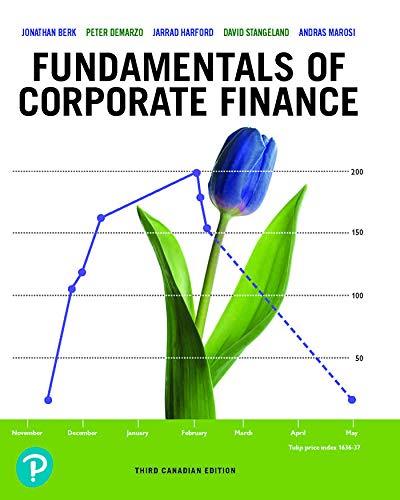Question
You are proposing a new venture, to branch out into animals and cartoon characters but this will require some new equipment and a capital outlay.
You are proposing a new venture, to branch out into animals and cartoon characters but this will require some new equipment and a capital outlay. Pertinent financial information is given below.
BALANCE SHEET
| Cash | 2,000,000 | Accounts Payable and Accruals | 18,000,000 |
| Accounts Receivable | 28,000,000 | Notes Payable | 40,000,000 |
| Inventories | 42,000,000 | Long-Term Debt | 60,000,000 |
|
|
| Preferred Stock | 10,000,000 |
| Net Fixed Assets | 133,000,000 | Common Equity | 77,000,000 |
|
|
|
|
|
| Total Assets | 205,000,000 | Total Claims | 205,000,000 |
Last years sales were $225,000,000.
The company has 60,000 bonds with a 30-year life outstanding, with 15 years until maturity. The bonds carry a 10 percent annual coupon, and are currently selling for $874.78.
You also have 100,000 shares of $100 par, 9% dividend perpetual preferred stock outstanding. The current market price is $90.00. Any new issues of preferred stock would incur a $3.00 per share flotation cost.
The company has 10 million shares of common stock outstanding with a currently price of $14.00 per share. The stock exhibits a constant growth rate of 10 percent. The last dividend (D0) was $.80. New stock could be sold with 15% flotation costs.
The risk-free rate is currently 6 percent, and the rate of return on the stock market as a whole is 14 percent. Your stocks beta is 1.22.
Stockholders require a risk premium of 5 percent above the return on the firms bonds.
The firm expects to have additional retained earnings of $10 million in the coming year, and expects depreciation expenses of $35 million.
Your firm does not use notes payable for long-term financing.
The firm considers its current market value capital structure to be optimal, and wishes to maintain that structure. (Hint: Examine the market value of the firms capital structure, rather than its book value.)
The firm is currently using its assets at capacity.
The firms management requires a 2 percent adjustment to the cost of capital for risky projects.
Your firms federal + state marginal tax rate is 40%.
Your firms dividend payout ratio is 50 percent, and net profit margin was 8.89 percent.
The firm has the following investment opportunities currently available in addition to the expansion you are proposing:
| Project | Cost | IRR |
| A | 10,000,000 | 20% |
| B | 20,000,000 | 18% |
| C | 15,000,000 | 14% |
| D | 30,000,000 | 12% |
| E | 25,000,000 | 10% |
Your expansion would consist of a new product introduction (You should label your venture as Project I, for introduction). You estimate that your product will have a six-year life span (after all how many people will really buy this stuff), and the equipment used to manufacture the project falls into the MACRS 5-year class. Your venture would require a capital investment of $15,000,000 in equipment, plus $2,000,000 in installation costs. The venture would also result in an increase in accounts receivable and inventories of $4,000,000. At the end of the six-year life span of the venture, you estimate that the equipment could be sold at a $4,000,000 salvage value.
Your venture, which management considers fairly risky, would increase fixed costs by a constant $1,000,000 per year, while the variable costs of the venture would equal 30 percent of revenues. You are projecting that revenues generated by the project would equal $5,000,000 in year 1, $10,000,000 in year 2, $14,000,000 in year 3, $16,000,000 in year 4, $12,000,000 in year 5, and $8,000,000 in year 6.
The following list of steps provides a structure that you should use in analyzing your new venture.
Note: Carry all final calculations to two decimal places.
Find the WACC:
1. Find the costs (rate of return under current market conditions) of the individual capital components: a. long-term debt (Hint: PV=-$874.78, FV = $1000, PMT=$100, n=15 solve for i) b. preferred stock c. retained earnings (avg. of CAPM and bond yield + risk premium approaches) d. new common stock
2. Compute the value of the long-term elements of the capital structure, and determine the target percentages for the optimal capital structure. (Carry weights to four decimal places. For example: 0.2973 or 29.73%)
Step by Step Solution
There are 3 Steps involved in it
Step: 1

Get Instant Access to Expert-Tailored Solutions
See step-by-step solutions with expert insights and AI powered tools for academic success
Step: 2

Step: 3

Ace Your Homework with AI
Get the answers you need in no time with our AI-driven, step-by-step assistance
Get Started


